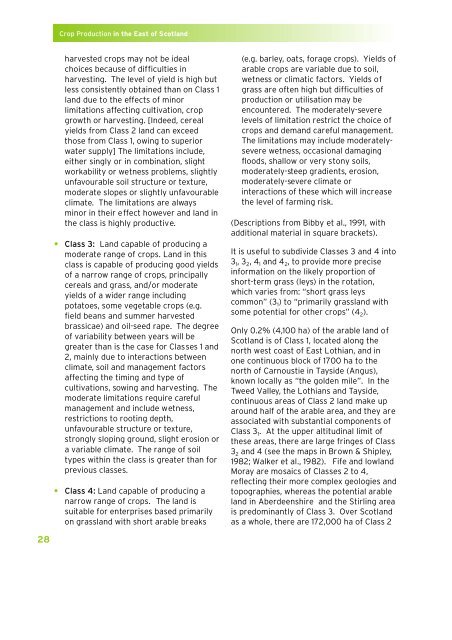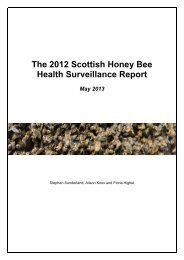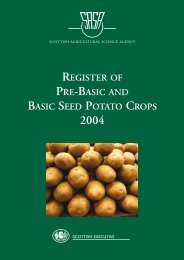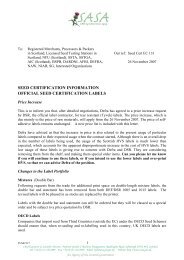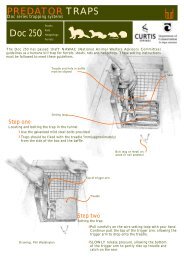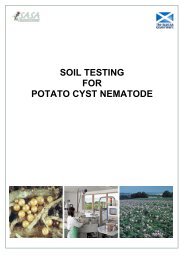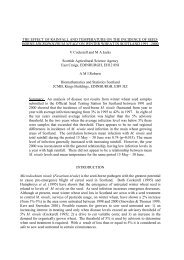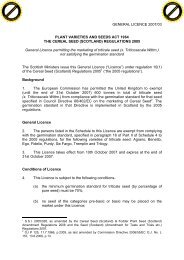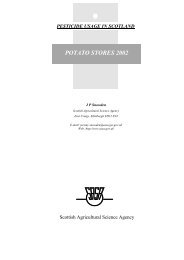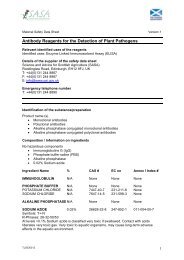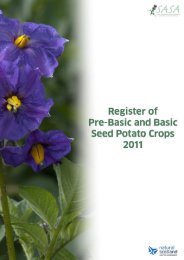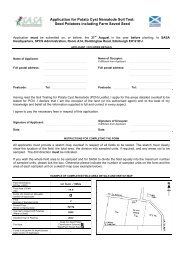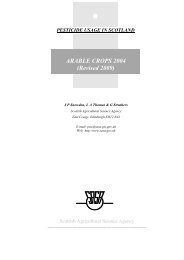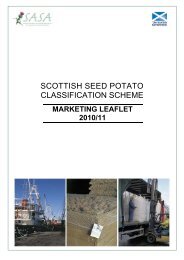Create successful ePaper yourself
Turn your PDF publications into a flip-book with our unique Google optimized e-Paper software.
<strong>Crop</strong> <strong>Production</strong> <strong>in</strong> <strong>the</strong> <strong>East</strong> <strong>of</strong> <strong>Scotland</strong>harvested crops may not be idealchoices because <strong>of</strong> difficulties <strong>in</strong>harvest<strong>in</strong>g. The level <strong>of</strong> yield is high butless consistently obta<strong>in</strong>ed than on Class 1land due to <strong>the</strong> effects <strong>of</strong> m<strong>in</strong>orlimitations affect<strong>in</strong>g cultivation, cropgrowth or harvest<strong>in</strong>g. [Indeed, cerealyields from Class 2 land can exceedthose from Class 1, ow<strong>in</strong>g to superiorwater supply] The limitations <strong>in</strong>clude,ei<strong>the</strong>r s<strong>in</strong>gly or <strong>in</strong> comb<strong>in</strong>ation, slightworkability or wetness problems, slightlyunfavourable soil structure or texture,moderate slopes or slightly unfavourableclimate. The limitations are alwaysm<strong>in</strong>or <strong>in</strong> <strong>the</strong>ir effect however and land <strong>in</strong><strong>the</strong> class is highly productive.• Class 3: Land capable <strong>of</strong> produc<strong>in</strong>g amoderate range <strong>of</strong> crops. Land <strong>in</strong> thisclass is capable <strong>of</strong> produc<strong>in</strong>g good yields<strong>of</strong> a narrow range <strong>of</strong> crops, pr<strong>in</strong>cipallycereals and grass, and/or moderateyields <strong>of</strong> a wider range <strong>in</strong>clud<strong>in</strong>gpotatoes, some vegetable crops (e.g.field beans and summer harvestedbrassicae) and oil-seed rape. The degree<strong>of</strong> variability between years will begreater than is <strong>the</strong> case for Classes 1 and2, ma<strong>in</strong>ly due to <strong>in</strong>teractions betweenclimate, soil and management factorsaffect<strong>in</strong>g <strong>the</strong> tim<strong>in</strong>g and type <strong>of</strong>cultivations, sow<strong>in</strong>g and harvest<strong>in</strong>g. Themoderate limitations require carefulmanagement and <strong>in</strong>clude wetness,restrictions to root<strong>in</strong>g depth,unfavourable structure or texture,strongly slop<strong>in</strong>g ground, slight erosion ora variable climate. The range <strong>of</strong> soiltypes with<strong>in</strong> <strong>the</strong> class is greater than forprevious classes.• Class 4: Land capable <strong>of</strong> produc<strong>in</strong>g anarrow range <strong>of</strong> crops. The land issuitable for enterprises based primarilyon grassland with short arable breaks(e.g. barley, oats, forage crops). Yields <strong>of</strong>arable crops are variable due to soil,wetness or climatic factors. Yields <strong>of</strong>grass are <strong>of</strong>ten high but difficulties <strong>of</strong>production or utilisation may beencountered. The moderately-severelevels <strong>of</strong> limitation restrict <strong>the</strong> choice <strong>of</strong>crops and demand careful management.The limitations may <strong>in</strong>clude moderatelyseverewetness, occasional damag<strong>in</strong>gfloods, shallow or very stony soils,moderately-steep gradients, erosion,moderately-severe climate or<strong>in</strong>teractions <strong>of</strong> <strong>the</strong>se which will <strong>in</strong>crease<strong>the</strong> level <strong>of</strong> farm<strong>in</strong>g risk.(Descriptions from Bibby et al., 1991, withadditional material <strong>in</strong> square brackets).It is useful to subdivide Classes 3 and 4 <strong>in</strong>to3 1 , 3 2 , 4 1 and 4 2 , to provide more precise<strong>in</strong>formation on <strong>the</strong> likely proportion <strong>of</strong>short-term grass (leys) <strong>in</strong> <strong>the</strong> rotation,which varies from: “short grass leyscommon” (3 1 ) to “primarily grassland withsome potential for o<strong>the</strong>r crops” (4 2 ).Only 0.2% (4,100 ha) <strong>of</strong> <strong>the</strong> arable land <strong>of</strong><strong>Scotland</strong> is <strong>of</strong> Class 1, located along <strong>the</strong>north west coast <strong>of</strong> <strong>East</strong> Lothian, and <strong>in</strong>one cont<strong>in</strong>uous block <strong>of</strong> 1700 ha to <strong>the</strong>north <strong>of</strong> Carnoustie <strong>in</strong> Tayside (Angus),known locally as “<strong>the</strong> golden mile”. In <strong>the</strong>Tweed Valley, <strong>the</strong> Lothians and Tayside,cont<strong>in</strong>uous areas <strong>of</strong> Class 2 land make uparound half <strong>of</strong> <strong>the</strong> arable area, and <strong>the</strong>y areassociated with substantial components <strong>of</strong>Class 3 1 . At <strong>the</strong> upper altitud<strong>in</strong>al limit <strong>of</strong><strong>the</strong>se areas, <strong>the</strong>re are large fr<strong>in</strong>ges <strong>of</strong> Class3 2 and 4 (see <strong>the</strong> maps <strong>in</strong> Brown & Shipley,1982; Walker et al., 1982). Fife and lowlandMoray are mosaics <strong>of</strong> Classes 2 to 4,reflect<strong>in</strong>g <strong>the</strong>ir more complex geologies andtopographies, whereas <strong>the</strong> potential arableland <strong>in</strong> Aberdeenshire and <strong>the</strong> Stirl<strong>in</strong>g areais predom<strong>in</strong>antly <strong>of</strong> Class 3. Over <strong>Scotland</strong>as a whole, <strong>the</strong>re are 172,000 ha <strong>of</strong> Class 228


